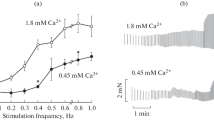Summary
Experimental depolarizations of various duration are induced on strips of frog's heart ventricle by the method ofKavaler. The time course of the mechanical responses (isometric contractures) is studied under the influence of variable Ca++-concentration and variable temperature. Short depolarizations are followed by contractures whose peak-time overlasts the depolarization considerably. This delay (between the instant of repolarization and that of the mechanical peak) decreases with increasing duration of depolarization. In short depolarizations, the delay increases with rising Ca++-concentration. Peak-time, at a depolarization time extrapolated to zero, depends on temperature with a Q10-value of −2.7, which remains constant throughout all Ca++-concentrations. Relaxation is delayed as by increasing Ca++-concentration as by decreasing temperature.
These findings agree with the activator-model fromHodgkin andHorowicz and may be explained with the assumption, that the temperature dependence on chemical processes responsible for the activation and inactivation of contractile mechanism is very high.
Zusammenfassung
Dem Ventrikelstreifen des Frosches wurden künstliche Depolarisationen verschiedener Dauer nach der Methode vonKavaler aufgezwungen. Der Zeitverlauf der mechanischen Antwort (isometrische Kontraktur) wurde unter dem Einfluß variabler Ca++-Konzentrationen und variabler Temperatur untersucht. Kurze Depolarisationen lösen Kontrakturen aus, deren Gipfelzeit die Depolarisation beträchtlich überdauert. Die Verzögerung zwischen Repolarisation und mechanischem Gipfel nimmt mit wachsender Dauer der Depolarisation ab. Bei kurzdauernden Depolarisationen wird die Verzögerung mit wachsender Ca++-Konzentration größer. Die Gipfelzeit für die auf Null extrapolierte Depolarisationsdauer hat einen Q10-Wert von −2,7, der unabhängig von der Ca++-Konzentration ist.
Die Erschlaffung wird sowohl durch Erhöhung der Ca++-Konzentration als auch durch Erniedrigung der Temperatur verzögert.
Die Ergebnisse stehen in Übereinstimmung mit dem Aktivator-Modell vonHodgkin u.Horowicz und können mit der Annahme eines sehr hohen Temperaturkoeffizienten der Prozesse, die für die Aktivierung und Inaktivierung des kontraktilen Apparates verantwortlich sind, erklärt werden.
Similar content being viewed by others
Literatur
Antoni, H., u.M. Rotmann: Zum Mechanismus der negativ inotropen Acetylcholinwirkung auf das isolierte Froschmyokard. Pflügers Arch. ges. Physiol.300, 67–86 (1968).
Bleichert, A., H. Reichel u.H. Ballhorn: Über elektrisch ausgelöste Kontrakturen am Skeletmuskel des Frosches. Pflügers Arch. ges. Physiol.282, 225–231 (1965).
Dudel, J., M. Morad, andR. Rüdel: Contractions of single crayfish muscle fibers induced by controlled changes of membrane potential. Pflügers Arch. ges. Physiol.299, 38–51 (1968).
—,K. Peper, andW. Trautwein: The contribution of Ca++ ions to the current voltage relation in cardiac muscle (Purkinje Fibre). Pflügers Arch. ges. Physiol.288, 262–281 (1966).
—, andR. Rüdel: Temperature dependence of electromechanical coupling in crayfish muscle fibers. Pflügers Arch. ges. Physiol.301, 16–30 (1968).
Hagiwara, S., K. Takahashi, andD. Junge: Excitation-contraction coupling in a barnacle muscle fibre as examined with voltage clamp technique. J. gen. Physiol.51, 157–175 (1968).
Hasselbach, W., u.M. Makinose: Die Calciumpumpe der “Erschlaffungsgrana” des Muskels und ihre Abhängigkeit von der ATP-Spaltung. Biochem. Z.333, 518–528 (1961).
Hodgkin, A. L., andP. Horowicz: Potassium contractures in single muscle fibres. J. Physiol. (Lond.)153, 386–403 (1960).
Kavaler, F.: Membrane depolarization as a cause of tension development in mammalian ventricular muscle. Amer. J. Physiol.197, 968–970 (1959).
Lüttgau, H. C.: The action of calcium ions on potassium contractures of single muscle fibres. J. Physiol. (Lond.)168, 679–697 (1963).
—, andR. Niedergerke: The antagonism between Ca and Na ions on the frog's heart. J. Physiol. (Lond.)143, 486–505 (1958).
Makinose, M., u.W. Hasselbach: Die Bedingungen der Calciumaufnahme durch ein Erschlaffungsgrana des Muskels. Pflügers Arch. ges. Physiol.274, 9 (1961).
Morad, M., andW. Trautwein: The effect of the duration of the action potential on contraction in the mammalian heart muscle. Pflügers Arch. ges. Physiol.299, 66–82 (1968).
Niedergerke, R.: The potassium chlorid contracture of the heart and its modification by calcium. J. Physiol. (Lond.)134, 584–599 (1956).
—: The rate of action of calcium ions on the contraction of the heart. J. Physiol. (Lond.)138, 506–515 (1957).
—: Movements of Ca in frog heart ventricles at rest and during contractures. J. Physiol. (Lond.)167, 515–550 (1963).
—: Movements of Ca in beating ventricles of the frog's heart. J. Physiol. (Lond.)167, 551–580 (1963).
—, andR. K. Orkand: The dual effect of calcium on the action potential of the frog's heart. J. Physiol. (Lond.)184, 291–311 (1966).
Reiter, M.: Der Einfluß der Natriumionen auf die Beziehung zwischen Frequenz und Kraft der Kontraktion des isolierten Meerschweinchenmyokards. Naunyn-Schmiedebergs Arch. Pharmak. exp. Path.254, 261–286 (1966).
Reuter, H. u.H. Scholz: Über den Einfluß der extracellulären Ca-Konzentration auf Membranpotential und Kontraktion isolierter Herzpräparate bei graduierter Depolarisation. Pflügers Arch. ges. Physiol.300, 87–107 (1968).
Stanley, E. J., andM. Reiter: The antagonistic effect of sodium and calcium on the action potential of guinea-pig papillary muscle. Naunyn-Schmiedebergs Arch. exp. Path. Pharmak.252, 159–172 (1965).
Weber, A., R. Herz, andI. Reiss: Study of the kinetics of calcium transport by isolated fragmented sarcoplasmic reticulum. Biochem. Z.345, 329–369 (1966).
Author information
Authors and Affiliations
Rights and permissions
About this article
Cite this article
Rumberger, E. Elektrisch ausgelöste Kontrakturen am Herzmuskel des Frosches und ihre Beeinflussung durch die äußere Calcium-Konzentration und die Temperatur. Pflugers Arch. 305, 250–261 (1969). https://doi.org/10.1007/BF00587279
Received:
Issue Date:
DOI: https://doi.org/10.1007/BF00587279
Key-Words
- Electro-mechanical Coupling
- External Ca++-Concentration
- Temperature Dependence of Contracture
- Heart Ventricle Strips of Frog




